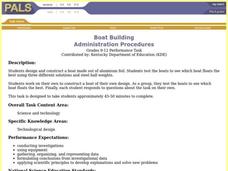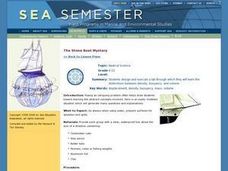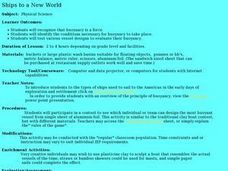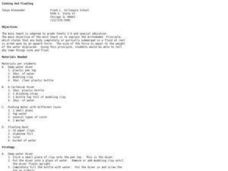Curated OER
Barge Building: What Floats Your Boat?
Students construct aluminum foil boats that float while holding the greatest number of pennies. They investigate the concept of water displacement, record their results, and watch a Bill Nye video on buoyancy.
Curated OER
Buoyant Boats
Learners design and construct a boat out of aluminum foil and a few other simple materials. The boats then be tested by floating them in water, then adding mass until they sink. They explore the various shapes of boat construction.
Curated OER
Aluminum Foil Boats
Learners design a boat of aluminum foil and calculate the density of the boat. Washers are added to the boat until it sinks. Students then redesign boat to hold more washers and recalculate the new density.
Curated OER
Boat Building
Students design and contrast a boat made out of aluminum foil. They test the boats to see which boat floats the best using three different solutions and steel ball weights. Students work on their own to construct a boat of their own...
Curated OER
Aluminum Boats
Students study buoyancy with an in-class experiment. In this water properties lesson, students create a boat from aluminum foil and float it in a bucket of water. Students utilize coins to change the weight of the boat and record data...
Curated OER
Float My Boat
Fourth graders, in groups, experiment with density and the displacement of water by creating and designing their own boats and seeing which boat holds the most centimeter cubes without sinking..
Curated OER
Designing and Floating Boats
Students participate in an experiment to determine if a toy boat will sink or float. They make the boats out of different materials and determine its carrying capacity by adding pennies. They graph their findings on a classroom graph.
Curated OER
The Stone Boat Mystery
Students design and execute a lab through which they study the distinctions between density, buoyancy, and volume.
Curated OER
Ships to a New World
Students experiment with buoyancy as a force. For this buoyancy lesson, students access an assigned website to examine the sailing vessels that came to the New World. They work as teams to build boats out of aluminum foil to see which...
Curated OER
What Boat Designs Float the Best?
Fifth graders investigate buoyancy by conducting a science experiment. In this water properties instructional activity, 5th graders predict which of their different paper boat designs will float for the longest period. Students conduct...
Curated OER
Sink or Float?
Have your class explore density and buoyancy using this resource. Learners read the book Who Sank the Boat, and use several items, such as rubber balls, bottle caps, wood, and other household items to conduct an experiment. Using a tub...
Curated OER
Push or Pull
Students discover that one way to change how something is moving is to give it a push or a pull. They design their own boats and work with 'The Great Boat Push' worksheet to compare how their boats move when they are pushed or pulled and...
Curated OER
I've Got That Sinking Feeling
Students design a simple boat and predict how much weight it can carry. They should also discover why objects float or sink and how this can be determined experimentally. A great lesson on buoyancy!
Curated OER
Surface Tension of Water
Students investigate surface tension, adhesion and cohesion. In this surface tension lesson plan, students complete 3 activities to better understand the concepts of surface tension, adhesion and cohesion. Students add drops of water to...
Curated OER
1st Grade - Act. 19: Will it Float?
First graders drop items into water, and discuss why some things float and others sink.
Curated OER
Sink or Float
Using a variety of objects, learners conduct buoyancy experiments. They make predictions on which object will sink or float and test their predictions. They use a graphic organizer to record their findings.
Curated OER
Sink or Float?
Students make and test predictions about sinking and floating, and classify objects according to whether they sink or float.
Curated OER
Sink or Float?
Young scholars will determine whether various objects sink or float in water. They do not need to explain why objects sink or float. They are rather to be encouraged to observe that the same objects will sink or float every time, i.e.,...
Curated OER
Sinking and Floating
Learners examine why some objects float or sink. In this physics lesson plan, students engage in several mini-experiments which challenge them to draw their own conclusions regarding why certain objects sink or float. An example of one...
Curated OER
Rock Cycle Activity
A few of the components of this instructional activity are not possible to carry out because the rock cycle diagram and challenge handouts are not included. Hopefully, you already have your own rock cycle diagram or worksheet to use as a...
Curated OER
Will it Float?
First graders discuss why some things sink and some float after dropping a variety of items into water.
Curated OER
Water and Ice
Students investigate the states of matter. In this physics lesson, students use water and ice to demonstrate the characteristics of a solid and liquid. Students record their observations as the state of the water changes.























